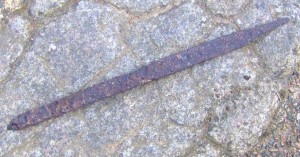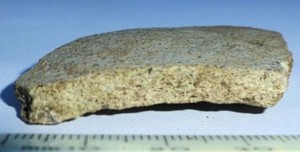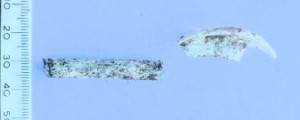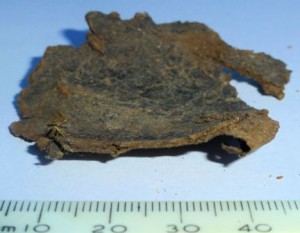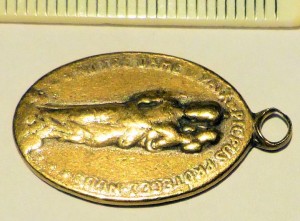New Archaeological Finds
More Archaeological Finds
By Clive Rodgers
Finds continue to be made in the Charlton Close/Station Road area of the village.
New fragments of pottery and other artifacts being exposed as a result of the long periods of torrential rain in January, 2014.
Part of a seax blade?
This is derived from the border of my own garden. An x-ray analysis at a university archaeology department would aid the identification for sure, it does have some similarities to the corroded central section of an anglo-saxon seax (a hunting knife), but it does appear to be forged iron.
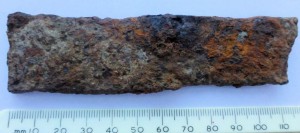
Forged iron find; January 2014, Charlton Close, Swanbourne, showing remnant dimple structures from forging could be remains of a large hunting knife.
They were in greatest use between about 500AD to 800AD, and it’s possibly a link to the original Anglo-Saxon settlement. The seax can vary a lot in length, some being as long as a small sword. Some would originally have blades on both sides, some only on one side. However, it could be a lot younger and may not be a true seax.
Iron forging and making a seax
The manufacture of a seax involved taking several twisted rods of iron (rectangular in section) and forging them together. Hence the structure in a broken section may appear to have remnant rod shapes.
On the artefact found, rod shapes are seen, but if this was an original blade edge it is corroded away. Corrosion may leave circular impressions from the forging process. Initial appearance is similar in the Charlton Close find, indicating metal forged in a similar way to a seax.
If a comparison is made with a confirmed seax of this type previously found from southern England, the overall shape becomes clear.
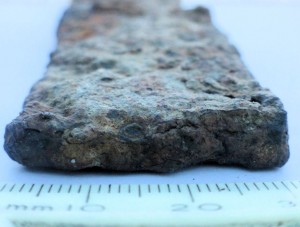
Probable central section of a seax, end-on, along a broken edge, found in Charlton Close, betrays structure made of forged iron rods.
Other late Saxon/early Medieval finds
Stamfordware is the first home-produced British medieval glazed ware.
It ranges in colour from whitish to pinkish-buff or pale grey, and may have a translucent glaze preserved.
It takes its name from Stamford in Lincolnshire, becoming common after 900AD.
Victorian finds
Degraded leather fragments (probably fragments of Victorian shoes) have been found, as have more fragments of clay pipes, including part of a pipe bowl.
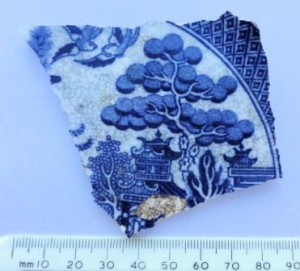
19th century willow pattern finds are probably the most common archaeological finds in Swanbourne. They look nice, but are of little value.
Medallion that could be Victorian to mid-20th Century.
This jewellery find was in the bank soil of Station Road. The inscription reads in French “NOTRE DAME DE PAIX PICPUS PROTECTEZ NOUS”, and it seems to be a good luck type of medallion jewellery probably purchased in Paris following a visit to the Notre Dame Picpus Cemetery Chapel, or may have a deeper link with the Chapel. Today it is an off the beaten track tourist destination, described by “Trip Adviser” as follows:-
“Picpus Cemetery, on the eastern side of Paris, is off the beaten tourist track, but well worth a visit. It is the only private cemetery in Paris and quite small in size compared with the other (public) cemeteries in Paris; what it lacks in size it has abundantly in historical importance and bittersweet memories.
For this is where 1306 persons from various social backgrounds , who were executed by guillotine in July 1794, at the Place du Trone (as it was then known, now known as Place de la Nation) were thrown under cover of night into two mass graves, at the bottom of a garden requisitioned from a former Convent.
Relatives of the victims secretly bought the area containing the two mass graves and subsequently adjoining lots as well, building a chapel for meditation and prayer. These families, some of them belonging to the French aristocracy (eg. the family of General LaFayette), use this cemetery for their family burials to this day.
The two mass graves remain at the bottom of the garden, marked by a cross. The chapel contains a complete list of victims. The gate, through which cartloads of victims of the guillotine were brought to be dumped into the two pits, could also be seen.
To reach Picpus Cemetery (closed on Monday, open other days 2-6 pm), take Metro Line 1 , direction Nation and get off at Station Picpus . From there it is a short walk to the cemetery, which is at 35 Rue de Picpus. A leaflet / map of the cemetery is available at the entrance for a small payment.
I have visited Paris many times – this was my most moving experience.”
The colour of the medallion is gold. The find was made before Christmas in the Station Road bank, not far from where previously I had found a Great Western Railway employee brass button. Perhaps, years ago, a pendant chain came loose when somebody was walking towards the rail station, got buried in mud at the edge of the bank and has been there ever since…..until now.
RETURN to Pre-History Category
Refer to Swanbourne Archaeology
This post has 3 Simple Fields-fields attached. Show fields.



